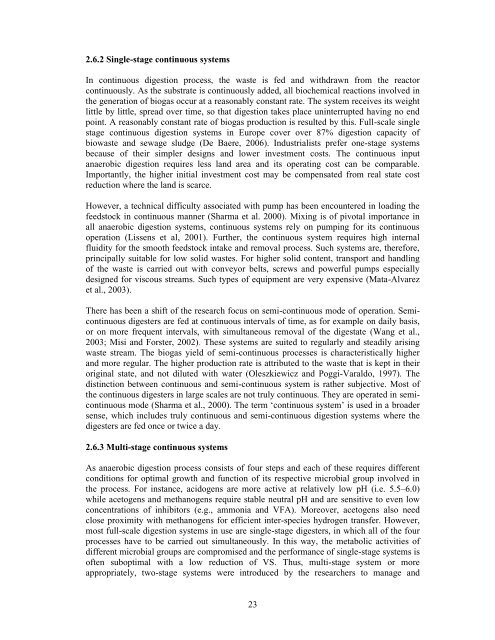dry anaerobic digestion of municipal solid waste and digestate ...
dry anaerobic digestion of municipal solid waste and digestate ...
dry anaerobic digestion of municipal solid waste and digestate ...
You also want an ePaper? Increase the reach of your titles
YUMPU automatically turns print PDFs into web optimized ePapers that Google loves.
2.6.2 Single-stage continuous systems<br />
In continuous <strong>digestion</strong> process, the <strong>waste</strong> is fed <strong>and</strong> withdrawn from the reactor<br />
continuously. As the substrate is continuously added, all biochemical reactions involved in<br />
the generation <strong>of</strong> biogas occur at a reasonably constant rate. The system receives its weight<br />
little by little, spread over time, so that <strong>digestion</strong> takes place uninterrupted having no end<br />
point. A reasonably constant rate <strong>of</strong> biogas production is resulted by this. Full-scale single<br />
stage continuous <strong>digestion</strong> systems in Europe cover over 87% <strong>digestion</strong> capacity <strong>of</strong><br />
bio<strong>waste</strong> <strong>and</strong> sewage sludge (De Baere, 2006). Industrialists prefer one-stage systems<br />
because <strong>of</strong> their simpler designs <strong>and</strong> lower investment costs. The continuous input<br />
<strong>anaerobic</strong> <strong>digestion</strong> requires less l<strong>and</strong> area <strong>and</strong> its operating cost can be comparable.<br />
Importantly, the higher initial investment cost may be compensated from real state cost<br />
reduction where the l<strong>and</strong> is scarce.<br />
However, a technical difficulty associated with pump has been encountered in loading the<br />
feedstock in continuous manner (Sharma et al. 2000). Mixing is <strong>of</strong> pivotal importance in<br />
all <strong>anaerobic</strong> <strong>digestion</strong> systems, continuous systems rely on pumping for its continuous<br />
operation (Lissens et al , 2001). Further, the continuous system requires high internal<br />
fluidity for the smooth feedstock intake <strong>and</strong> removal process. Such systems are, therefore,<br />
principally suitable for low <strong>solid</strong> <strong>waste</strong>s. For higher <strong>solid</strong> content, transport <strong>and</strong> h<strong>and</strong>ling<br />
<strong>of</strong> the <strong>waste</strong> is carried out with conveyor belts, screws <strong>and</strong> powerful pumps especially<br />
designed for viscous streams. Such types <strong>of</strong> equipment are very expensive (Mata-Alvarez<br />
et al., 2003).<br />
There has been a shift <strong>of</strong> the research focus on semi-continuous mode <strong>of</strong> operation. Semicontinuous<br />
digesters are fed at continuous intervals <strong>of</strong> time, as for example on daily basis,<br />
or on more frequent intervals, with simultaneous removal <strong>of</strong> the <strong>digestate</strong> (Wang et al.,<br />
2003; Misi <strong>and</strong> Forster, 2002). These systems are suited to regularly <strong>and</strong> steadily arising<br />
<strong>waste</strong> stream. The biogas yield <strong>of</strong> semi-continuous processes is characteristically higher<br />
<strong>and</strong> more regular. The higher production rate is attributed to the <strong>waste</strong> that is kept in their<br />
original state, <strong>and</strong> not diluted with water (Ole szkiewicz <strong>and</strong> Poggi-Varaldo, 1997). The<br />
distinction between continuous <strong>and</strong> semi-continuous system is rather subjective. Most <strong>of</strong><br />
the continuous digesters in large scales are not truly continuous. They are operated in semicontinuous<br />
mode (Sharma et al., 2000). The term ‘continuous system’ is used in a broader<br />
sense, which includes truly continuous <strong>and</strong> semi-continuous <strong>digestion</strong> systems where the<br />
digesters are fed once or twice a day.<br />
2.6.3 Multi-stage continuous systems<br />
As <strong>anaerobic</strong> <strong>digestion</strong> process consists <strong>of</strong> four steps <strong>and</strong> each <strong>of</strong> these requires different<br />
conditions for optimal growth <strong>and</strong> function <strong>of</strong> its respective microbial group involved in<br />
the process. For instance, acidogens are more active at relatively low pH (i.e. 5.5–6.0)<br />
while acetogens <strong>and</strong> methanogens require stable neutral pH <strong>and</strong> are sensitive to even low<br />
concentrations <strong>of</strong> inhibitors (e.g., ammonia <strong>and</strong> VFA). Moreover, acetogens also need<br />
close proximity with methanogens for efficient inter-species hydrogen transfer. However,<br />
most full-scale <strong>digestion</strong> systems in use are single-stage digesters, in which all <strong>of</strong> the four<br />
processes have to be carried out simultaneously. In this way, the metabolic activities <strong>of</strong><br />
different microbial groups are compromised <strong>and</strong> the performance <strong>of</strong> single-stage systems is<br />
<strong>of</strong>ten suboptimal with a low reduction <strong>of</strong> VS. Thus, multi-stage system or more<br />
appropriately, two-stage systems were introduced by the researchers to manage <strong>and</strong><br />
23

















